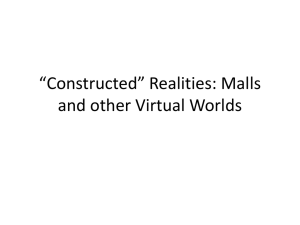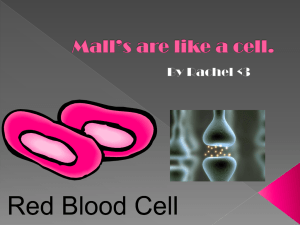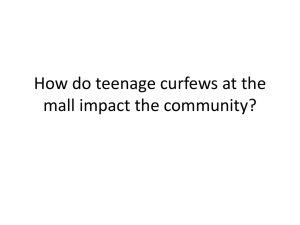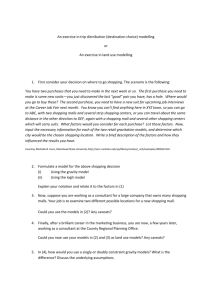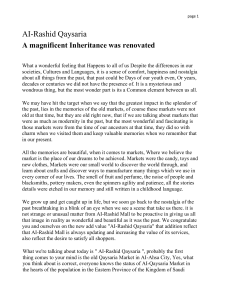Preparation for writing a summary
advertisement
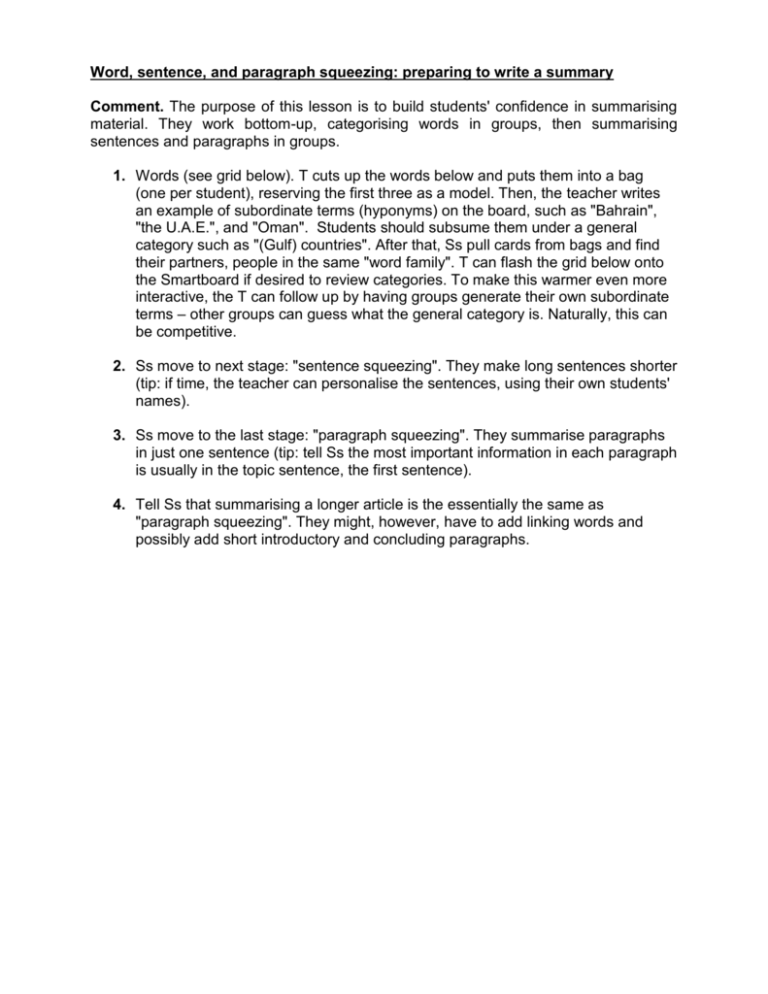
Word, sentence, and paragraph squeezing: preparing to write a summary Comment. The purpose of this lesson is to build students' confidence in summarising material. They work bottom-up, categorising words in groups, then summarising sentences and paragraphs in groups. 1. Words (see grid below). T cuts up the words below and puts them into a bag (one per student), reserving the first three as a model. Then, the teacher writes an example of subordinate terms (hyponyms) on the board, such as "Bahrain", "the U.A.E.", and "Oman". Students should subsume them under a general category such as "(Gulf) countries". After that, Ss pull cards from bags and find their partners, people in the same "word family". T can flash the grid below onto the Smartboard if desired to review categories. To make this warmer even more interactive, the T can follow up by having groups generate their own subordinate terms – other groups can guess what the general category is. Naturally, this can be competitive. 2. Ss move to next stage: "sentence squeezing". They make long sentences shorter (tip: if time, the teacher can personalise the sentences, using their own students' names). 3. Ss move to the last stage: "paragraph squeezing". They summarise paragraphs in just one sentence (tip: tell Ss the most important information in each paragraph is usually in the topic sentence, the first sentence). 4. Tell Ss that summarising a longer article is the essentially the same as "paragraph squeezing". They might, however, have to add linking words and possibly add short introductory and concluding paragraphs. Word squeezing Categories: countries, vegetables, stationery, electronic gadgets, automobile names, transportation, nationalities, fruit (four for odd numbers in class). Bahrain the U.A.E. Oman onion cucumber carrot paper pencil stapler phone I-pod mp3 player BMW Hyundai Mitsubishi bus car bicycle Omani Saudi Emirati apple pear banana guava Sentence “squeezing” Rewrite these sentences using summary words and phrases. Write a shorter sentence, choosing only the most important words or ideas. #1 is an example. 1. After she turned on the oven, T.J. mixed the sugar, flour, eggs, milk, oil, and vanilla in the mixer, poured the batter into the buttered pans, and put the cake in the oven. ________T.J. baked a cake._________________________________________ 2. Abdulla picked up his laptop from the table near the door, put on his shoes, and walked outside to his car. ___________________________________________________________________ 3. When Khalifa reached his car, he saw the window was broken, the stereo missing, and his laptop gone. ___________________________________________________________________ 4. In Mohamed's mp3 library collection, you can find mysteries, novels, biographies, how-to manuals, and science fiction thrillers. ___________________________________________________________________ 5. With his new credit card, Saif bought groceries at the supermarket, shoes at a department store, and a new set of tires for his sports car at an auto supply store. ___________________________________________________________________ 6. Eid and Ibraheem like to go walking, in-line skating, jogging, hiking, and bicycling. ___________________________________________________________________ 7. After clearing away the old leaves and branches, Tariq dug up the hard ground, mixed in fertiliser and new soil, raked it all smooth and planted seeds. ___________________________________________________________________ 8. Bader owns an mp3 player, up-to-date mobile, i-pod, and very cool camera. ___________________________________________________________________ 9. When Masooad and Salem heard about the imminent desert storm, they closed the windows, put tape across the glass, and moved plants and chairs indoors. ___________________________________________________________________ 10. Ayman put his pens and pencils neatly in a row, turned off the radio, put his books on his desk, and sat down in his chair. ___________________________________________________________________ Sentence “squeezing” (key) Rewrite these sentences using summary words and phrases. Write a shorter sentence, choosing only the most important words or ideas. #1 is an example. 1. After she turned on the oven, T.J. mixed the sugar, flour, eggs, milk, oil, and vanilla in the mixer, poured the batter into the buttered pans, and put the cake in the oven. T.J. baked a cake. 2. Abdulla picked up his laptop from the table near the door, put on his shoes, and walked outside to his car. Abdulla got ready for work/school. 3. When Khalifa reached his car, he saw the window was broken, the stereo missing, and his laptop gone. Khalifa was robbed. 4. In Mohamed's mp3 library collection, you can find mysteries, novels, biographies, how-to manuals, and science fiction thrillers. Mohamed has many mp3 books. 5. With his new credit card, Saif bought groceries at the supermarket, shoes at a department store, and a new set of tires for his sports car at an auto supply store. Saif purchased several items (using his new credit card). 6. Eid and Ibraheem like to go walking, in-line skating, jogging, hiking, and bicycling. Ibraheem and Eid like doing sports/exercise. (note the change in word order for names – no "copy paste"!) 7. After clearing away the old leaves and branches, Tariq dug up the hard ground, mixed in fertiliser and new soil, raked it all smooth and planted seeds. Tariq planted a garden. 8. Bader owns an mp3 player, up-to-date mobile, i-pod, and very cool camera. Bader has many electronic gadgets. 9. When Masooad and Salem heard about the imminent desert storm, they closed the windows, put tape across the glass, and moved plants and chairs indoors. Salem and Masooad prepared for the storm. (note the change in word order for names – no "copy paste"!) 10. Ayman put his pens and pencils neatly in a row, turned off the radio, put his books on his desk, and sat down in his chair. Ayman got ready to study. Paragraph “squeezing” It is usually possible to summarise a paragraph in one or two sentences. In order to do so, read the paragraph, making sure you understand the main ideas, and b) look at the topic sentence. If it’s a good topic sentence, you can use this as a base for your summary. For the paragraphs below, write a one-sentence summary. Ex. Shopping malls have produced a revolution in shopping and living habits in many industrialised countries. Before 1950, there were no malls, but now almost every city or region in industrialised countries has one. Many people even think of them as social centers. In a way, malls have taken the place of the main streets of a town or city. Shops and services that were once spread over several city blocks are now in one place at the mall. Everyone can save time by doing their shopping at the mall. Now people young and old, with time on their hands, often say, “Let’s go to the mall!” Summary: (Growing numbers of) shopping malls have changed the cultures of numerous industrialised countries. Although every shopping mall is a big different in design, shoppers often feel comfortable in a new mall. That is because malls share certain features. You can almost always find most of the following: a department store, a pharmacy, a toy store, a bookshop, clothing shops for all ages, shoe shops, a bank, and places to eat. These businesses are all under one roof. Most malls are enclosed so that shoppers never have to go outdoors once they get to the mall. Some malls also have doors to shops on the outside of the mall. Usually a mall is surrounded by a large parking area. Summary: ___________________________________________________________ ____________________________________________________________ Malls are not exactly alike, however. In the suburb of a large city, the local mall may be large and beautiful. It may be several stories high, housing as many as fifty businesses. These can range from small specialty shops to large luxury department stores. The roofs of these malls are sometimes made of glass, and there may be a courtyard with plants and mountains. In a poor, rural town, however, the local mall may be plain and rather small. It may offer only essential shopping and services such as a supermarket, a pizza parlor, a card and gift shop, a Laundromat, and a bank. All the shops are generally on one level and the interior of the mall is plain and undecorated. Summary: ____________________________________________________________ ____________________________________________________________ While shopping malls have changed life in the modern world, not all of their effects have been positive. Most of the shops and services found in malls are parts of large corporations. These businesses take away customers from smaller shops in nearby towns, forcing many of them to close. That has led to fewer individually owned businesses and less control over jobs. In addition, malls are harmful to the environment. They are often built on land that is important to the survival of birds and wild animals. Wherever they are built, they cover large areas with buildings and parking lots – instead of grass and trees. Thus, they contribute to the general loss of nature and rainwater to refill underground aquifers. Finally, malls are usually built far away from the city or town centre. This means that people must drive their car to the mall, resulting in increased air pollution and heavy traffic on nearby roads. Summary: ____________________________________________________________ ____________________________________________________________ Paragraph “squeezing” (key) It is usually possible to summarise a paragraph in one or two sentences. In order to do so, read the paragraph, making sure you understand the main ideas, and b) look at the topic sentence. If it’s a good topic sentence, you can use this as a base for your summary. For the paragraphs below, write a one-sentence summary. Ex. Shopping malls have produced a revolution in shopping and living habits in many industrialised countries. Before 1950, there were no malls, but now almost every city or region in industrialised countries has one. Many people even think of them as social centers. In a way, malls have taken the place of the main streets of a town or city. Shops and services that were once spread over several city blocks are now in one place at the mall. Everyone can save time by doing their shopping at the mall. Now people young and old, with time on their hands, often say, “Let’s go to the mall!” Summary: (Growing numbers of) shopping malls have changed the cultures of numerous industrialised countries. Although every shopping mall is a big different in design, shoppers often feel comfortable in a new mall. That is because malls share certain features. You can almost always find most of the following: a department store, a pharmacy, a toy store, a bookshop, clothing shops for all ages, shoe shops, a bank, and places to eat. These businesses are all under one roof. Most malls are enclosed so that shoppers never have to go outdoors once they get to the mall. Some malls also have doors to shops on the outside of the mall. Usually a mall is surrounded by a large parking area. Summary: (Almost) all shopping malls have similar characteristics. Malls are not exactly alike, however. In the suburb of a large city, the local mall may be large and beautiful. It may be several stories high, housing as many as fifty businesses. These can range from small specialty shops to large luxury department stores. The roofs of these malls are sometimes made of glass, and there may be a courtyard with plants and mountains. In a poor, rural town, however, the local mall may be plain and rather small. It may offer only essential shopping and services such as a supermarket, a pizza parlor, a card and gift shop, a Laundromat, and a bank. All the shops are generally on one level and the interior of the mall is plain and undecorated. Summary: Malls vary in luxury according to their geographical location. (or: Large cities have more luxurious malls while small ones have simpler ones.) While shopping malls have changed life in the modern world, not all of their effects have been positive. Most of the shops and services found in malls are parts of large corporations. These businesses take away customers from smaller shops in nearby towns, forcing many of them to close. That has led to fewer individually owned businesses and less control over jobs. In addition, malls are harmful to the environment. They are often built on land that is important to the survival of birds and wild animals. Wherever they are built, they cover large areas with buildings and parking lots – instead of grass and trees. Thus, they contribute to the general loss of nature and rainwater to refill underground aquifers. Finally, malls are usually built far away from the city or town centre. This means that people must drive their car to the mall, resulting in increased air pollution and heavy traffic on nearby roads. Summary: Malls often negatively effect their local areas/the surrounding area.
